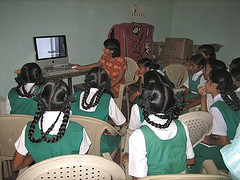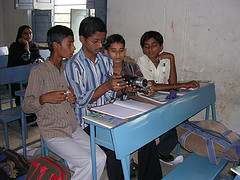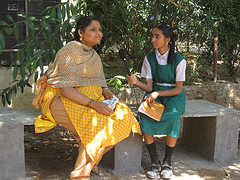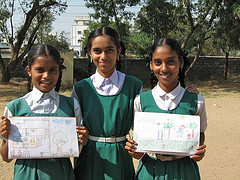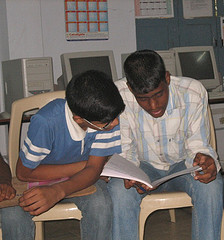User:Themodernstory
About
The Modern Story introduces youth around the world to 21st century tools of communication, enabling them to tell stories of personal, social, and environmental importance.
The Modern Story Fellowship is a grassroots initiative that 1) introduces to, and then sustains progressive pedagogies and a creative multimedia curriculum in governmental schools in the greater Hyderabad region, and 2) offers undergraduates and recent graduates of the U.S., the opportunity to participate directly in volunteer work abroad within the field of education and technology.
Website: http://themodernstory.wordpress.com
Fellowship: http://themodernstory.wordpress.com/fellowship/
The Bigger Story…
As Time Magazine recognized in 2006, “the Person of the Year” is “You.” This hasn’t changed. With the advent of user-based technology, once marginalized populations now have the power of connection to become upwardly mobile. Past errors of blind philanthropy make clear that we cannot implement change unless we listen to the stories of those who need it. And in a technologically-advanced age that still values the narrative, digital storytelling is the way to encourage and empower this voice.
In 2006 Muhammad Yunus was awarded the Nobel Peace Prize for what is, from a logical point of view, a most simple idea. Micro finance is a theory devoted to the individual, a concept that gets trampled by the masses in a country like India. In giving one person a sum of as little as twenty-seven dollars, that person has the chance to assert their economic value in a community that is too often labeled as “unbankable”. In terms of economics, these people are finally on their way. But how do we translate this economic model into the educational realm? By empowering under-privileged students with a voice - an identity in their world of anonymity. However, this voice alone is not enough. It needs legs to reach the wider world that the innovative and widely accessible form of digital stories provides.
Thus, The Modern Story has introduced digital storytelling to the non-profit sector by bringing this medium to governmental secondary school systems in India. We have collaborated with the American India Foundation, an NGO of seven years that is generating significant social and economic change throughout the country. Their Digital Equalizer Program aims to 1) educate the 50 to 60 million children currently not enrolled in school, and 2) bridge the gap between technology and the third world.
The interdisciplinary and open source nature of the digital storytelling form and the curriculum TMS has designed will have multiple benefits: 1.) the children will gain a sense of self-empowerment through a voice, 2.) the children will find a creative outlet and have a meaningful and polished product to share with others, 3.) the children will learn and incorporate more advanced literacy skills, writing techniques and a set of twenty-first century technological skills that are essential to the mobility of any population in the world today, and 4.) the families of the children, their schools and surrounding communities will gain a better understanding of the children’s needs through public viewings of the stories. What better way to generate change in a community than to allow its individuals to identify the obstacles and work with assistance towards the best-fitted solutions?
Following a history of oral and written tradition, digital stories combine image, sound, and voiceover to preserve the importance of personal narrative within cultures. While speaking to the multiple perspectives and simultaneous existences of individuals and their communities as a whole, it is a globally recognized social software tool that has been used to resolve conflicts such as AIDS in South Africa. The sharing of stories through this medium generates change by spreading awareness and initiating conversation. Digital stories empower the individual with a voice as well as teach literacy, writing techniques and a set of twenty-first century technological skills that are essential to the mobility of any population in the world today.
Program Details…
We have installed a Digital Media Station at two schools in Andhra Pradesh, India: C. Ramchand Girl’s High School in Hyderabad and A.P. Boys Residential School in Nalgonda, a village just outside of Hyderabad. Each station includes an iMac desktop with imaging and sound editing software (Final Cut Express), a digital camera, and a video camera.
Our lesson plan consists of four components that encourage students to reflect on their educational experiences, their family backgrounds and the social issues their communities face. The four components are: 1) stories without words and sounds – students will explore their surroundings through photography (image), 2) soundscapes – students will record the sounds of their environments and explore musical expression (audio), 3) the role of language – students will engage in creative writing exercises such as monologues and script writing (written), and 4) digital stories – students will use the above skills to create a final video product consisting of image, sound and text. In doing so, the students will use critical thinking and exercise both the left and right sides of the brain to create a multi-dimensional story. With the finished products we will make a series of DVDs and post these stories on this weblog, which will become an open and interactive space for the students, their communities, and for government and organizations to utilize.
This project’s first field run began in January 2008 and continued through March. In brief, the twenty-four students and two teachers involved in this project gained knowledge of and experience with digital cameras, video cameras, microphones, a Mac editing station, and film-editing software (Final Cut Express). The students became familiar with the technical skills through small introductory projects about their lives at school and progressed to making twenty-minute documentaries about important issues facing their communities like “Women and Education”, and about solving the problems in their local township of Nalgonda. The students learned the pre-production (conceptualizing), production (shooting) and post-production (editing) phases of video production, and they created several projects entirely on their own. In addition to gaining a multimedia skill set the students gained exposure to a new teaching style and curriculum that embraces progressive pedagogies, such as experiential and self-motivated learning. The students also developed both written and verbal expression and found and exercised a creative and socially aware voice in a community thirsty for change.
Most importantly, a learning environment of trust and openness was formed between the students and us and a global connection was generated through broadcasting the students’ projects to the wider world via this weblog. Please continue to follow The Modern Story and watch as the stories of individuals and groups of people unfold!
Media
Link to the students' stories and multimedia work HERE.
© The Modern Story
